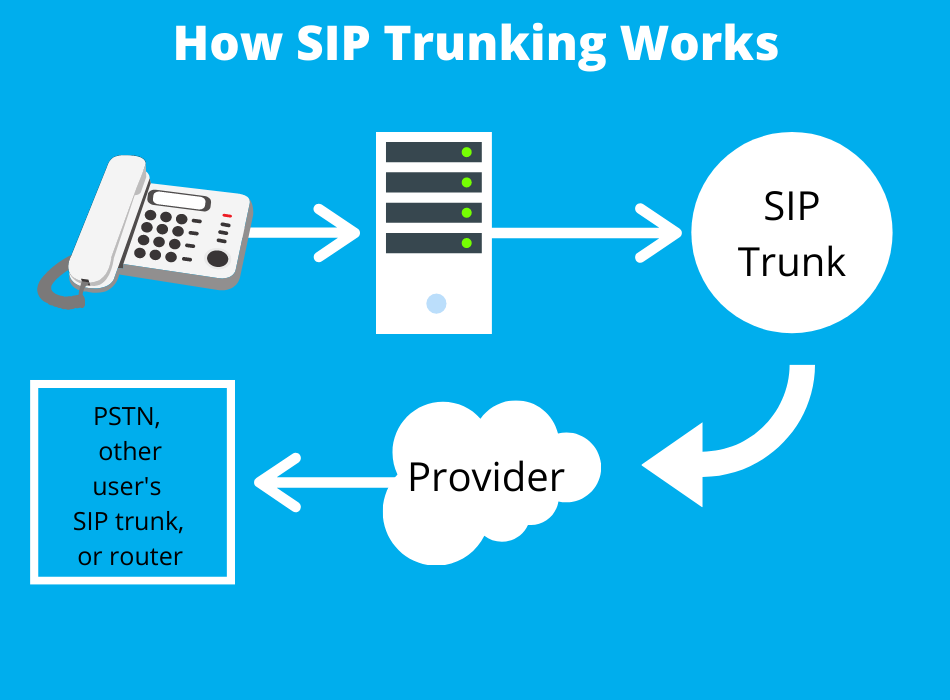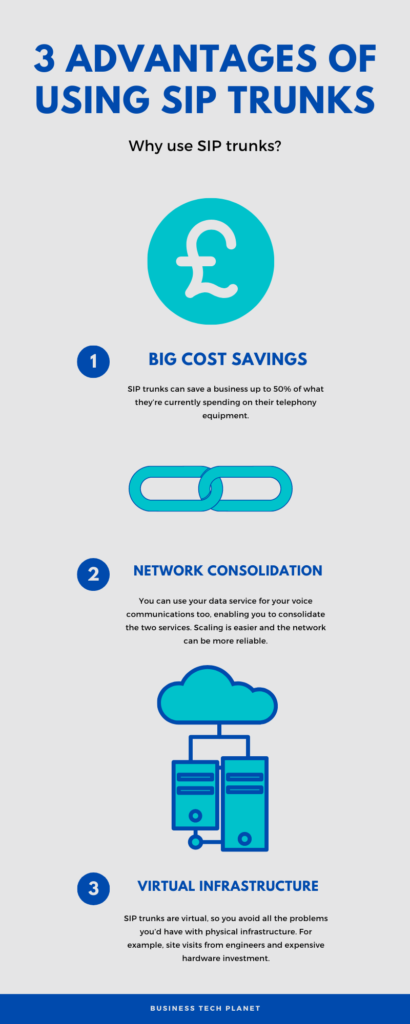As businesses look to save money and move over to more cost-effective technology solutions, terms like hosted VoIP and SIP trunking will crop up time and time again. Despite knowing this technology might save you a lot of money, you may not have the knowledge you need to put your faith into new technology. I’ve written this blog post to tell you what SIP trunks are and how they can save your business money.
What are SIP trunks? A SIP trunk is a virtual version of an analog phone line. A SIP trunk essentially connects your office PBX to the outside world, enabling you to make calls over the internet using your PBX.
Using SIP trunks, your monthly costs will usually decrease as you no longer have to pay for physical ISDN lines into your building. You can still use the PBX you’ve already paid for and utilise your data connection to make and receive calls. In this blog post, I’ll explain what a SIP trunk is used for, how many SIP trunks you need, and the advantages of using SIP trunks.
How Do SIP Trunks Work?
Now we have a basic idea of what a SIP trunk is, we’ll have a look at how SIP trunks work. Firstly, understanding what SIP means is integral to understanding how SIP trunks actually work.
SIP stands for Session Initiation Protocol. SIP is a signalling protocol which is used for starting, maintaining, and terminating multimedia communication sessions between two endpoints. For example, a phone call between two people.
When you make a VoIP call, SIP is the protocol that establishes the connection between the two devices. Using SIP, voice, pictures, videos, and documents can be transmitted rather than just voice signals. There are several protocols that can be used for VoIP, such as the H.323 protocol, but SIP is the most common.
So now we know what SIP stands for, let’s take a look at how SIP trunks actually work.

As you can see in the image above, you initiate the phone call. The signals then travel through your PBX and are directed to your VoIP provider over a data network by the SIP trunk. Once the signal reaches your provider, your call is diverted to the right place, whether that be the PSTN, another building’s SIP trunk, or another user’s router.
Before SIP trunks and internet telephony, companies would have ISDN circuits installed on their premises. SIP trunks replace the physical circuits and calls are sent over data networks instead. This makes no difference to you, the end-user. The call experience will be identical. By using SIP trunking, you simply replace physical infrastructure with virtual infrastructure. Thanks to SIP trunking, setting up a telephone system is now much cheaper. In addition, less maintenance is needed since the infrastructure is virtual rather than physical.
If you’re spending a fortune on ISDN lines into your property, SIP trunking can save you a lot of money. Even better, you don’t have to sacrifice anything in terms of quality as part of making the change. You’re ready to begin using SIP trunks right away if you have the following:
- A stable, reliable internet connection
- IP phones, or analog phones with VoIP adapters fitted
- An IP PBX (Private Branch Exchange), AKA SIP-compatible PBX
If your current PBX hardware isn’t SIP-compatible, you can adapt your system to begin using SIP trunks. You can purchase a piece of hardware called a SIP-ISDN gateway. This piece of hardware converts your conventional PBX so that it can work with SIP trunks. While a SIP-ISDN gateway is potentially expensive, it will be much cheaper than purchasing a brand new IP PBX to replace your current hardware.

How Many SIP Trunks Does Your Business Need?
If you have determined that you want to start using SIP trunks, it’s important to decide how many SIP trunks your business needs.
The number of SIP trunks your business needs will depend on the provider that you choose, as well as the number of SIP channels you need. Here’s how you can determine the number of SIP trunks that your business will need.
The term SIP channels essentially means calls. So one call is one SIP channel, and 10 calls is 10 SIP channels. So here’s what you need to know before even beginning to decide how many SIP trunks you need:
- How many concurrent calls you’ll be making
- How many channels are available using SIP trunks from your chosen provider
- Whether or not you will have peak times in the year where you receive substantially more calls
Find Out How Many Channels Per Trunk Your Chosen Provider Offers
Depending on the provider that you choose, the number of trunks that you need will differ.
Every provider is different. Some providers will only support 5 calls per trunk, whereas another may support 30 calls per trunk. Because of this, you will need to find out how many channels per trunk the provider you have chosen supports.
It’s important to know how many channels per trunk your chosen provider offers, as it will impact your costs. If you need 5 trunks from one provider but you only need 1 from another, you’ll end up spending more than you have to.
If you start speaking to providers, just remember that the words ‘channel’ and ‘line’ are interchangeable. And keep in mind that most providers will allow you to add and remove channels at any time. So you don’t need a SIP trunk allowing for 100 channels just because you have 100 staff, unless those staff would all be making calls at the same time.
How Many Concurrent Calls Will You Be Making?
Before deciding on anything, you will need to know how many concurrent calls you will be making. The number of concurrent calls you’ll be making will be a deciding factor in the number of SIP trunks your business needs.
Some businesses will only make 10 calls at any given time, whereas others will make 50 calls at the same time. Of course, this will have an impact on how many SIP trunks you will need.
When considering how many concurrent calls you will be making, it’s also essential to think about unique circumstances. For example, if there was a fault with your service, you may suddenly receive a massive influx of calls. Don’t just think about the number of calls that you receive on an average day; make sure you have spare capacity so your system isn’t overwhelmed if you suddenly receive more calls than anticipated.
3 Advantages Of Using SIP Trunks
Now you know the basics of SIP trunks and how they work, let’s have a look at some of the advantages. If you still aren’t convinced that SIP trunking is the right option for your business, perhaps these advantages will convince you further.

1. Big Cost Savings
Physical ISDN lines can cost businesses a fortune. Installation costs can be significant, but ongoing maintenance is also required. On top of that, ISDN is a technology of days gone as an increasing number of businesses move over to VoIP.
According to Gartner research director Sorell Slaymaker, SIP trunks can save a business up to 50% of what they’re currently spending on their telephony equipment.
There are several reasons that SIP trunks can save a business so much money. Installing SIP trunks is cheaper, because there isn’t really any installation at all. It is perhaps best described as configuring, since nothing physical is being set up. Ongoing maintenance costs are much lower, because SIP trunks can be managed remotely if there are any issues. There are other factors that impact the price of SIP trunks too, but these are two of the biggest reasons that moving over to SIP trunks can save you so much money.
2. Network Consolidation
Many companies in the world are still paying for voice and data services separately. Now you can use your data service for your voice communications too, enabling you to consolidate the two services.
Using your data connection for your voice service as well should ultimately reduce your costs. The only extra consideration here is you might have to upgrade your data connection if your current service doesn’t have enough bandwidth to handle your voice service too.
Alongside reducing your costs, there is also the added benefit of streamlining your business’s services. By consolidating your voice and data connections, you have one network to manage. For most businesses, this will mean a more reliable and sustainable network.
3. Virtual Rather Than Physical Infrastructure
Physical infrastructure is expensive to install and challenging to maintain. On top of that, growing your system in the future can be difficult due to costs and time.
SIP trunks are virtual, so you avoid all the problems you’d have with physical infrastructure. You won’t have to pay for an engineer to visit your premises and install anything, and your system will easily scale as your company grows.
With SIP trunks, return-on-investment is almost guaranteed. With low upfront investment and the flexibility virtual infrastructure enables, you will have a solution that works for your business forever.
